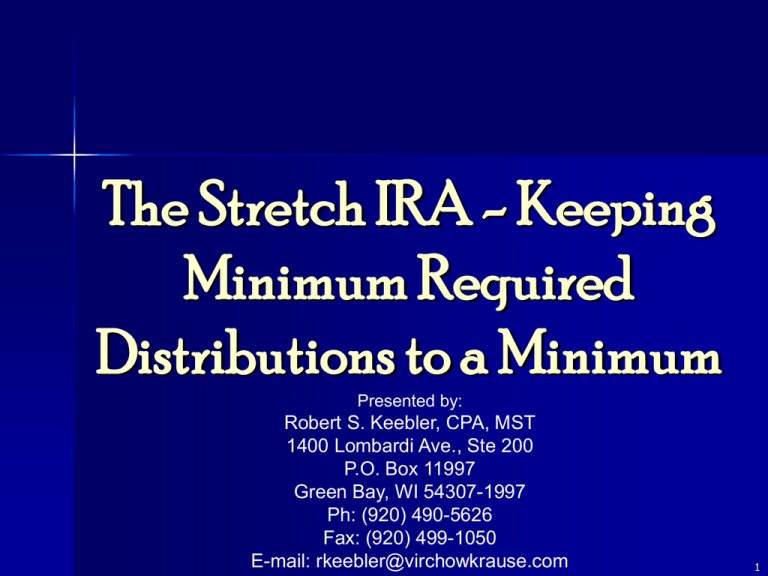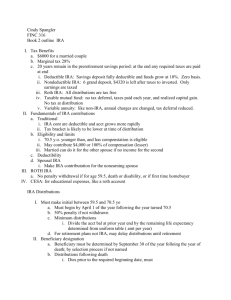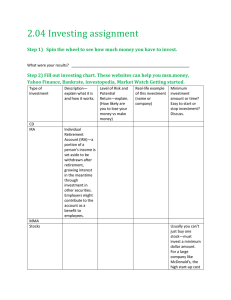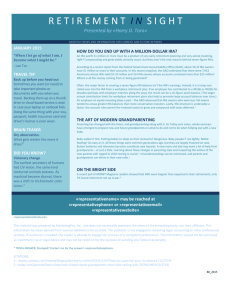Keebler powerpoint
advertisement

The Stretch IRA - Keeping Minimum Required Distributions to a Minimum Presented by: Robert S. Keebler, CPA, MST 1400 Lombardi Ave., Ste 200 P.O. Box 11997 Green Bay, WI 54307-1997 Ph: (920) 490-5626 Fax: (920) 499-1050 E-mail: rkeebler@virchowkrause.com 1 Why Retirement Distribution Planning is Important Potential tax exposure to IRA without planning Net to Family 29.00% Federal & State Estate Tax, 50.00% Income Tax, 21.00% 2 Why Retirement Distribution Planning is Important Perhaps one of the most important decisions a retiree must make is to determine from which retirement assets to withdraw funds to meet everyday living expenses 3 Why Retirement Distribution Planning is Important Qualified Retirement Account vs. Non-Qualified Account Distributions Decision factors Size of accounts Investment mix / performance Marginal income tax bracket Time horizon 4 Why Retirement Distribution Planning is Important OPTION 1 - Withdraw 100% From IRA Husband's Age Wife's Age ASSETS IRA Beginning Balance Income Distributions Ending Balance Brok erage Account Beginning Balance Yield (Interest & Dividends) Growth Subtotal Yield Disributed Stock Sales Net Cash Flow Reinvested Ending Balance Total Assets CASH FLOW IRA Distribution Interest & Dividends Stock Sales Proceeds Subtotal Less: Income Tax Less: Living Expenses Net Cash Flow $ 64 59 65 60 66 61 67 62 68 63 2007 2008 2009 2010 2011 1,300,000 $ 91,000 (175,000) 1,216,000 $ 1,216,000 $ 85,120 (173,500) 1,127,620 $ 1,127,620 $ 78,933 (172,000) 1,034,553 $ 1,034,553 $ 72,419 (170,500) 936,472 $ 936,472 65,553 (169,000) 833,025 $ 1,400,000 $ 28,000 70,000 1,498,000 $ (28,000) 4,010 1,474,010 $ 1,474,010 $ 29,480 73,701 1,577,191 $ (29,480) 3,997 1,551,707 $ 1,551,707 $ 31,034 77,585 1,660,327 $ (31,034) 4,033 1,633,325 $ 1,633,325 $ 32,667 81,666 1,747,658 $ (32,667) 4,122 1,719,113 $ 1,719,113 34,382 85,956 1,839,451 (34,382) 4,266 1,809,335 $ 2,690,010 2,679,327 2,667,879 2,655,585 2,642,360 7.00% $ $ 2.00% 5.00% $ $ $ $ $ 2007 175,000 $ 28,000 203,000 $ (66,990) (132,000) 4,010 $ $ 2008 173,500 $ 29,480 202,980 $ (66,983) (132,000) 3,997 $ $ 2009 172,000 $ 31,034 203,034 $ (67,001) (132,000) 4,033 $ $ 2010 170,500 $ 32,667 203,167 $ (67,045) (132,000) 4,122 $ 2011 169,000 34,382 203,382 (67,116) (132,000) 4,266 5 Why Retirement Distribution Planning is Important OPTION 2 - Withdraw 100% From Brokerage Account Husband's Age Wife's Age ASSETS IRA Beginning Balance Income Distributions Ending Balance Brok erage Account Beginning Balance Yield (Interest & Dividends) Growth Subtotal Yield Disributed Stock Sales Net Cash Flow Reinvested Ending Balance Total Assets CASH FLOW IRA Distribution Interest & Dividends Stock Sales Proceeds Subtotal Less: Income Tax Less: Living Expenses Net Cash Flow $ 7.00% $ $ 64 59 65 60 66 61 67 62 68 63 2007 2008 2009 2010 2011 1,300,000 91,000 1,391,000 $ $ 1,391,000 97,370 1,488,370 $ $ 1,488,370 104,186 1,592,556 $ $ 1,592,556 111,479 1,704,035 $ $ 1,704,035 119,282 1,823,317 $ 1,400,000 $ 28,000 70,000 1,498,000 $ (28,000) (130,000) 4,910 1,344,910 $ 1,344,910 $ 26,898 67,245 1,439,053 $ (26,898) (131,500) 4,803 1,285,459 $ 1,285,459 $ 25,709 64,273 1,375,441 $ (25,709) (133,000) 4,659 1,221,390 $ 1,221,390 $ 24,428 61,070 1,306,887 $ (24,428) (134,500) 4,472 1,152,431 $ 1,152,431 23,049 57,622 1,233,101 (23,049) (136,000) 4,238 1,078,291 $ 2,735,910 2,773,829 2,813,946 2,856,466 2,901,608 2.00% 5.00% $ $ $ $ $ $ $ $ 2007 2008 2009 2010 2011 $ 28,000 130,000 158,000 $ (21,090) (132,000) 4,910 $ $ 26,898 131,500 158,398 $ (21,595) (132,000) 4,803 $ $ 25,709 133,000 158,709 $ (22,051) (132,000) 4,659 $ $ 24,428 134,500 158,928 $ (22,456) (132,000) 4,472 $ 23,049 136,000 159,049 (22,810) (132,000) 4,238 6 Why Retirement Distribution Planning is Important Total Assets $4,500,000 $4,000,000 $3,500,000 $3,000,000 $2,500,000 $2,000,000 $1,500,000 $1,000,000 $500,000 $5 10 20 30 Year 100% IRA Distribution 100% Brokerage Account Distribution 7 Foundation Concepts Wills control probate assets Trusts control trust assets IRAs and qualified retirement plans are controlled by beneficiary designation form or default provisions of contract 8 Foundation Concepts IRAs are not taxed until distributed Distributions must begin no later than one’s Required Beginning Date (RBD) IRA Elections are required after death Roth IRA conversions must be analyzed Use of life insurance to prolong distributions 9 Foundation Concepts Taxation of IRA Distributions To the extent that an IRA has only deductible contributions (plus income and growth), 100% of each IRA distribution will be subject to income tax in the year of distribution To the extent that an IRA has non-deductible contributions, a portion of each IRA distribution will not be subject to tax 10 Foundation Concepts Taxation of IRA Distributions When an IRA has non-deductible contributions, a portion of each IRA distribution will be a return of non-taxable “basis” to the IRA owner In determining the non-taxable portion of an IRA distribution, all IRAs and IRA distributions during the year (including outstanding rollovers) must be combined for apportioning “basis” – See IRS Form 8606 11 Foundation Concepts Taxation of IRA Distributions “Basis” Apportionment Formula - Example Current year non-deductible IRA contributions Prior year non-deductible IRA contributions Total non-deductible IRA contributions $ FMV of all IRAs Outstanding rollovers Distributions Roth IRA conversions Total value of IRAs, distributions and Roth IRA conversions $ $ $ "Basis" apportionment formula Gross IRA distribution Non-taxable portion Taxable IRA distribution 1,000 6,000 7,000 320,000 20,000 10,000 350,000 0.0200 $ $ 10,000 (200) 9,800 12 Foundation Concepts Generally, April 1 of the year following the year the owner turns age 70½ is the RBD Once at RBD, required minimum distributions (RMD) must begin 13 Foundation Concepts Required Beginning Date - Example Example-Birthdate is October 18, 1937 – Turn age 70 on October 18, 2007 – Turn age 70½ on April 18, 2008 – RBD -- April 1, 2009 Example-Birthdate is April 18, 1937 – Turn age 70 on April 18, 2007 – Turn age 70½ on October 18, 2007 – RBD -- April 1, 2008 14 Foundation Concepts RMDs are calculated based upon prior year ending account balance divided by life expectancy factor RMD = Prior Year 12/31 Balance Life Expectancy Factor 15 Foundation Concepts Life expectancy tables – Uniform Lifetime Table – Single Life Table – Joint and Last Survivor Table Available where the spouse is the sole beneficiary and is greater than 10 years younger than the account owner 16 Foundation Concepts Uniform Lifetime Table A ge Diviso r A ge Diviso r A ge Diviso r 70 27.4 86 14.1 102 5.5 71 26.5 87 13.4 103 5.2 72 73 25.6 24.7 88 89 12.7 12.0 104 105 4.9 4.5 74 23.8 90 11.4 106 4.2 75 76 22.9 22.0 91 92 10.8 10.2 107 108 3.9 3.7 77 21.2 93 9.6 109 3.4 78 79 20.3 19.5 94 95 9.1 8.6 110 111 3.1 2.9 80 18.7 96 8.1 112 2.6 81 17.9 97 7.6 113 2.4 82 83 17.1 16.3 98 99 7.1 6.7 114 115 and older 2.1 1.9 84 85 15.5 14.8 100 101 6.3 5.9 17 Foundation Concepts Single Life Table A ge Diviso r A ge Diviso r A ge Diviso r A ge Diviso r A ge Diviso r A ge Diviso r A ge Diviso r 0 82.4 16 66.9 32 51.4 48 36.0 64 21.8 80 10.2 96 3.8 1 81.6 17 66.0 33 50.4 49 35.1 65 21.0 81 9.7 97 3.6 2 80.6 18 65.0 34 49.4 50 34.2 66 20.2 82 9.1 98 3.4 3 79.7 19 64.0 35 48.5 51 33.3 67 19.4 83 8.6 99 3.1 4 78.7 20 63.0 36 47.5 52 32.3 68 18.6 84 8.1 100 2.9 5 77.7 21 62.1 37 46.5 53 31.4 69 17.8 85 7.6 101 2.7 6 76.7 22 61.1 38 45.6 54 30.5 70 17.0 86 7.1 102 2.5 7 75.8 23 60.1 39 44.6 55 29.6 71 16.3 87 6.7 103 2.3 8 74.8 24 59.1 40 43.6 56 28.7 72 15.5 88 6.3 104 2.1 9 73.8 25 58.2 41 42.7 57 27.9 73 14.8 89 5.9 105 1.9 10 72.8 26 57.2 42 41.7 58 27.0 74 14.1 90 5.5 106 1.7 11 71.8 27 56.2 43 40.7 59 26.1 75 13.4 91 5.2 107 1.5 12 70.8 28 55.3 44 39.8 60 25.2 76 12.7 92 4.9 108 1.4 13 69.9 29 54.3 45 38.8 61 24.4 77 12.1 93 4.6 109 1.2 14 68.9 30 53.3 46 37.9 62 23.5 78 11.4 94 4.3 110 1.1 15 67.9 31 52.4 47 37.0 63 22.7 79 10.8 95 4.1 111 1.0 18 Foundation Concepts Post-death critical questions: Did the participant die before his RBD? Is the spouse the sole beneficiary? Are there multiple beneficiaries? Are all beneficiaries “designated beneficiaries”? What does the IRA/qualified plan allow? 19 Foundation Concepts Permissible “designated beneficiaries”: – Individuals Spouse Child Grandchild Parent Brother/sister Niece/Nephew Neighbor − Certain Trusts 20 Foundation Concepts Death before age 70½ – – – – Five-year rule Exceptions to the five-year rule Delayed distributions – spousal beneficiary Spousal beneficiary – special trust problem Death after age 70½ – Life expectancy distributions if you have a designated beneficiary – Distributions must begin by December 31st of the year after death – Year of death distribution – life expectancy of IRA owner 21 Foundation Concepts Death Before Required Beginning Date Designated Beneficiary NonDesignated Beneficiary Death On or After Required Beginning Date Life Expectancy Rule Life Expectancy Rule Five-Year Rule “Ghost” Life Expectancy Rule 22 Foundation Concepts Critical dates: September 30 of the year following the year of death – Date at which the beneficiaries are identified October 31 of the year following the year of death – Date at which trust documentation (in the case where as trust is named as a designated beneficiary) must be filed December 31 of the year following the year of death – Date at which the first distribution must be made by each IRA beneficiary – Date at which separate shares must be created 23 “Inherited” IRA Objective: Prolong IRA payments over longest possible period of time, thus increasing wealth to future generations 24 “Inherited” IRA An IRA is treated as “inherited” if the individual for whose benefit the IRA is maintained acquired the IRA on account of the death of the original owner. Under the tax law the IRA assets can be distributed based upon the life expectancy of the beneficiary. 25 “Inherited” IRA Two Strategies – Spousal Rollover – Inherited IRA Advantages – Rollover delays RMD until spouse’s own RBD – Inherited IRA provisions allow beneficiary’s life expectancy to be used for distributions after death of IRA owner 26 “Inherited” IRA Key Issues in Making the “Inherited IRA” Work Beneficiary Designation Forms Tax Apportionment Irrevocable Life Insurance Trust (ILIT) 27 “Inherited” IRA Spousal Beneficiary - Rollover Exception to Inherited IRA rules Only available to surviving spouse Allows spouse to roll over assets received as beneficiary to a new IRA in his/her own name Spouse’s age used to determine when required minimum distributions must begin Spouse may use the Uniform Lifetime Table to determine distributions 28 “Inherited” IRA Child / Grandchild Beneficiary Utilizes the exemption to the five year rule Avoids IRA assets being subject to estate tax in spouse’s estate Achieves “Inherited IRA” to the degree that distributions occur over life expectancy of the designated beneficiary 29 “Inherited” IRA Child / Grandchild Beneficiary Life expectancy of child and/or grandchild determined in year after year of the IRA owner’s death by reference to the Single Life Table and then is reduced by a value of one each subsequent year 30 “Inherited” IRA Pension Protection Act of 2006 Beginning in 2007, non-spousal beneficiaries (e.g. children, grandchildren, friends, etc.) are permitted to roll over a qualified retirement plan (e.g. 401(k)), via a trustee-to-trustee transfer, into an “inherited” IRA “Designated beneficiary” trusts are also permitted to roll over qualified retirement plans to “inherited” IRAs 31 “Inherited” IRA Common Mistakes to Avoid Incorrect titling Failure to take RMDs Failure to utilize disclaimers when appropriate Failure to analyze contingent beneficiaries when utilizing disclaimers Taking a lump-sum distribution 32 “Inherited” IRA Common Mistakes to Avoid Spousal rollover before age 59 ½ – Will cause pre-59 ½ distributions to be subject to the 10% early distribution penalty. – If no rollover occurred, pre-59 ½ distributions can be taken penalty free. Solution – Do not perform spousal rollover until spouse reaches age 59 ½. 33 “Inherited” IRA Common Mistakes to Avoid For non-spousal beneficiaries, it is critical to keep inherited IRA in the name of the deceased IRA owner. Example (Individual): “John Smith, deceased, IRA for the benefit of James Smith” Example (Trust): “John Smith, deceased, IRA for the benefit of James Smith as Trustee of the Smith Family Trust dated 1/1/2007.” 34 “Inherited” IRA “Inherited” IRA Analysis – Case Study Benefits – Effectively shows the additional wealth generated by naming a qualified designated beneficiary of an IRA – Provides a framework as to how to structure the IRA Trust – Serves as a guide for post-mortem distributions 35 “Inherited” IRA “Inherited” IRA Analysis – Case Study Scenarios – Immediate distribution – IRA payable to non-qualified beneficiary (five-year rule) – IRA payable to surviving spouse (spousal rollover) – IRA payable to child 36 “Inherited” IRA “Inherited” IRA Analysis – Case Study Assumptions – IRA owner’s age - 68 – Spouse’s age – 67 – Child’s age – 35 – IRA balance - $500,000 – Brokerage account balance - $0 – Pre-tax growth rate – 8% – Ordinary income tax rate – 40% – Capital gains tax rate – 20% 37 “Inherited” IRA “Inherited” IRA Analysis – Case Study Yr 5 10 15 20 25 30 35 40 Immediate Distribution $ 424,713 $ 601,269 $ 851,222 $ 1,205,083 $ 1,706,047 $ 2,415,265 $ 3,419,312 $ 4,840,750 IRA Payable to NonQualified Beneficiary (Five-Year Rule) $ 734,664 $ 624,042 $ 883,462 $ 1,250,725 $ 1,770,662 $ 2,506,742 $ 3,548,817 $ 5,024,091 IRA Payable to Surviving Spouse (Spousal Rollover) $ 712,898 $ 965,679 $ 1,296,715 $ 1,727,638 $ 2,313,679 $ 3,210,501 $ 4,434,486 $ 6,093,099 IRA Payable to Child $ 709,235 $ 993,194 $ 1,384,000 $ 1,917,956 $ 2,641,305 $ 3,611,318 $ 4,896,101 $ 6,571,657 38 “Inherited” IRA “Inherited” IRA Analysis – Case Study IRA Transfer to Family $ 7, 000, 000 $ 6, 000, 000 $ 5, 000, 000 $ 4, 000, 000 $ 3, 000, 000 $ 2, 000, 000 $ 1, 000, 000 $5 10 15 20 25 30 35 40 Ye a r Immediate Distributio n IRA P ayable to No n-Qualified B eneficiary (Five-Year Rule) IRA P ayable to Surviving Spo use (Spo usal Ro llo ver) IRA P ayable to Child 39 “Inherited” IRA “Inherited” IRA Analysis – Case Study IRA Transfer to Family $1,100,000 $965,679 $1,000,000 $993,194 $900,000 $800,000 $700,000 $601,269 $624,042 $600,000 $500,000 10 Ye a r Immediate Distribution IRA Payable to Non-Qualified Beneficiary (Five-Year Rule) IRA Payable to Surviving Spouse (Spousal Rollover) IRA Payable to Child 40 “Inherited” IRA “Inherited” IRA Analysis – Case Study IRA Transfer to Family $1,917,956 $2,000,000 $1,727,638 $1,750,000 $1,500,000 $1,250,000 $1,205,083 $1,250,725 $1,000,000 20 Ye a r Immediate Distribution IRA Payable to Non-Qualified Beneficiary (Five-Year Rule) IRA Payable to Surviving Spouse (Spousal Rollover) IRA Payable to Child 41 “Inherited” IRA “Inherited” IRA Analysis – Case Study IRA Transfer to Family $7,000,000 $6,571,657 $6,500,000 $6,093,099 $6,000,000 $5,500,000 $5,000,000 $4,840,750 $5,024,091 $4,500,000 40 Ye a r Immediate Distribution IRA Payable to Non-Qualified Beneficiary (Five-Year Rule) IRA Payable to Surviving Spouse (Spousal Rollover) IRA Payable to Child 42 IRAs Payable to Trusts How an IRA is Payable to a Trust IRA Beneficiary Designation Form Trust IRA distributions over the life expectancy of the oldest beneficiary Spouse Children 43 IRAs Payable to Trusts Benefits of Using a Trust Spendthrift protection Creditor protection Divorce protection Special needs Investment management Estate planning “Dead-hand” control 44 IRAs Payable to Trusts Disadvantages of Using a Trust Trust tax rates Legal and trustee fees Income tax returns Greater complexity 45 Disclaimer Planning Disclaimer must be “qualified.” In writing Within 9 months No acceptance of the interest or any of its benefits, Interest passes without any direction on the part of the person making the disclaimer 46 Disclaimer Planning Example Alex dies at age 70. Alex’s wife disclaims amount of Alex’s unified credit to bypass trust for benefit of herself and their children – Disclaimer must occur within nine months from date of death – Disclaimer must be served to the IRA custodian – Disclaimer must be fractional to avoid immediate income taxation 47 Roth IRAs 100% of growth is tax-exempt No required minimum distributions at age 70½ – NOTE: Distributions from Roth IRAs cannot be used to fulfill the RMD from a traditional IRA $100,000 Modified Adjusted Gross Income (MAGI) limitation RMDs on Inherited Roth IRAs Roth 401(k) plans 48 Roth IRAs Starting in 2010, the $100,000 Adjusted Gross Income (AGI) limitation no longer applies – The tax incurred on a Roth IRA conversion in 2010 may be spread over the following two tax years (i.e. 2011 and 2012) Married Filing Separately taxpayers can convert to a Roth IRA 49 Roth IRAs Convertible accounts – – – – – Traditional IRAs 401(k) plans (Starting in 2008) Profit sharing plans (Starting in 2008) 403(b) annuity plans (Starting in 2008) 457 plans (Starting in 2008) Non-Convertible accounts – “Inherited” IRAs – Education IRAs 50 Roth IRAs Taxation of Distributions Basis Can be Withdrawn Tax-Free (FIFO Method) Distributions are not subject to income tax if they do not exceed aggregate contributions and/or conversions to the Roth IRA Withdrawals made within five years of conversion if owner under age 59½ and no other exception applies Five-year period independent of five-year period for qualified distribution 51 Roth IRAs Seven Reasons to Convert to Roth IRAs (1) Taxpayers have special favorable tax attributes including charitable deduction carry-forwards, investment tax credits, etc. (2) Suspension of the minimum distribution rules at age 70½ provides a considerable advantage to the Roth IRA holder. (3) Taxpayers benefit from paying income tax before estate tax (when a Roth IRA election is made) compared to the income tax deduction obtained when a traditional IRA is subject to estate tax. (4) Taxpayers who can pay the income tax on the IRA from non IRA funds benefit greatly from the Roth IRA because of the ability to enjoy greater tax-free yields. 52 Roth IRAs Seven Reasons to Convert to Roth IRAs (5) Taxpayers who need to use IRA assets to fund their Unified Credit bypass trust are well advised to consider making a Roth IRA election for that portion of their overall IRA funds. (6) Taxpayers making the Roth IRA election during their lifetime reduce their overall estate, thereby lowering the effect of higher estate tax rates. (7) Because federal tax brackets are more favorable for married couples filing joint returns than for single individuals, Roth IRA distributions won’t cause an increase in tax rates for the surviving spouse when one spouse is deceased because the distributions are taxfree. 53 Roth IRAs Understanding the Mechanics The key to successful Roth IRA conversions is to keep as much of the conversion income as possible in the current marginal tax bracket – However, there are times when it may make sense to convert more and go into higher tax brackets 54 Roth IRAs Understanding the Mechanics Optimum Roth IRA conversion amount? 35% tax bracket Target Roth IRA conversion amount 33% tax bracket Current taxable income 28% tax bracket 25% tax bracket 15% tax bracket 10% tax bracket 55 Roth IRAs Understanding the Mechanics Example 1 – Same Growth & Tax Rates Beginning Balance Income Tax on Withdrawal After-Tax Balance No Conversion Traditional Brokerage IRA Account Total $ 1,000,000 $ 400,000 $ 1,400,000 $ (400,000) $ $ (400,000) $ 600,000 $ 400,000 $ 1,000,000 Roth IRA Conversion Brokerage Roth IRA Account Total $ 1,000,000 $ 400,000 $ 1,400,000 $ $ (400,000) $ (400,000) $ 1,000,000 $ $ 1,000,000 Balance in 10 Years Income Tax on Withdrawal After-Tax Balance $ 1,967,151 $ $ (786,861) $ $ 1,180,291 $ 786,861 786,861 $ 2,754,012 $ (786,861) $ 1,967,151 $ 1,967,151 $ $ 1,967,151 $ $ $ - Balance in 20 Years Income Tax on Withdrawal After-Tax Balance $ 3,869,684 $ 1,547,874 $ (1,547,874) $ $ 2,321,811 $ 1,547,874 $ 5,417,558 $ (1,547,874) $ 3,869,684 $ 3,869,684 $ $ 3,869,684 $ $ $ Balance in 30 Years Income Tax on Withdrawal After-Tax Balance $ 7,612,255 $ 3,044,902 $ (3,044,902) $ $ 4,567,353 $ 3,044,902 $ 10,657,157 $ (3,044,902) $ 7,612,255 $ 7,612,255 $ $ 7,612,255 $ $ $ Difference ($) $ - $ 1,967,151 $ $ 1,967,151 $ - - $ 3,869,684 $ $ 3,869,684 $ - - $ 7,612,255 $ $ 7,612,255 $ - ASSUMPTIONS: Pre-Tax Grow th Rate on IRA = 7.00% After-Tax Grow th Rate on Brokerage Account = 7.00% Combined Income Tax Rate - Withdraw al Years = 40.00% Combined Income Tax Rate - Conversion Year = 40.00% 56 Roth IRAs Understanding the Mechanics Example 2 – Same Tax Rates / Different Growth Rates Beginning Balance Income Tax on Withdrawal After-Tax Balance No Conversion Traditional Brokerage IRA Account Total $ 1,000,000 $ 400,000 $ 1,400,000 $ (400,000) $ $ (400,000) $ 600,000 $ 400,000 $ 1,000,000 Roth IRA Conversion Brokerage Roth IRA Account Total $ 1,000,000 $ 400,000 $ 1,400,000 $ $ (400,000) $ (400,000) $ 1,000,000 $ $ 1,000,000 Balance in 10 Years Income Tax on Withdrawal After-Tax Balance $ 1,967,151 $ $ (786,861) $ $ 1,180,291 $ 683,258 683,258 $ 2,650,409 $ (786,861) $ 1,863,549 $ 1,967,151 $ $ 1,967,151 $ $ $ - $ 1,967,151 $ $ 1,967,151 $ 103,603 Balance in 20 Years Income Tax on Withdrawal After-Tax Balance $ 3,869,684 $ 1,167,103 $ (1,547,874) $ $ 2,321,811 $ 1,167,103 $ 5,036,787 $ (1,547,874) $ 3,488,914 $ 3,869,684 $ $ 3,869,684 $ $ $ - $ 3,869,684 $ $ 3,869,684 $ 380,771 Balance in 30 Years Income Tax on Withdrawal After-Tax Balance $ 7,612,255 $ 1,993,581 $ (3,044,902) $ $ 4,567,353 $ 1,993,581 $ 9,605,836 $ (3,044,902) $ 6,560,934 $ 7,612,255 $ $ 7,612,255 $ $ $ - $ 7,612,255 $ $ 7,612,255 $ 1,051,322 Difference $ $ - ASSUMPTIONS: Pre-Tax Grow th Rate on IRA = 7.00% After-Tax Grow th Rate on Brokerage Account = 5.50% Combined Income Tax Rate - Withdraw al Years = 40.00% Combined Income Tax Rate - Conversion Year = 40.00% 57 Roth IRAs Understanding the Mechanics Example 3 – Different Growth & Tax Rates (Higher Tax Rate in Future Years) Beginning Balance Income Tax on Withdrawal After-Tax Balance No Conversion Traditional Brokerage IRA Account Total $ 1,000,000 $ 400,000 $ 1,400,000 $ (400,000) $ $ (400,000) $ 600,000 $ 400,000 $ 1,000,000 Roth IRA Conversion Brokerage Roth IRA Account Total $ 1,000,000 $ 400,000 $ 1,400,000 $ $ (300,000) $ (300,000) $ 1,000,000 $ 100,000 $ 1,100,000 $ 100,000 Balance in 10 Years Income Tax on Withdrawal After-Tax Balance $ 1,967,151 $ $ (786,861) $ $ 1,180,291 $ 683,258 $ 2,650,409 $ (786,861) 683,258 $ 1,863,549 $ 1,967,151 $ $ $ $ 1,967,151 $ 170,814 $ 2,137,966 $ 170,814 $ 2,137,966 $ 274,417 Balance in 20 Years Income Tax on Withdrawal After-Tax Balance $ 3,869,684 $ 1,167,103 $ 5,036,787 $ (1,547,874) $ $ (1,547,874) $ 2,321,811 $ 1,167,103 $ 3,488,914 $ 3,869,684 $ $ $ $ 3,869,684 $ 291,776 $ 4,161,460 $ 291,776 $ 4,161,460 $ 672,547 Balance in 30 Years Income Tax on Withdrawal After-Tax Balance $ 7,612,255 $ 1,993,581 $ 9,605,836 $ (3,044,902) $ $ (3,044,902) $ 4,567,353 $ 1,993,581 $ 6,560,934 $ 7,612,255 $ $ $ $ 7,612,255 $ 498,395 $ 8,110,650 $ 498,395 $ 8,110,650 $ 1,549,717 Difference ($) ASSUMPTIONS: Pre-Tax Grow th Rate on IRA = 7.00% After-Tax Grow th Rate on Brokerage Account = 5.50% Combined Income Tax Rate - Withdraw al Years = 40.00% Combined Income Tax Rate - Conversion Year = 30.00% 58 Roth IRAs Understanding the Mechanics Taxpayers may recharacterize (i.e. “undo”) the Roth IRA conversion in current year or by the filing date of the current year’s tax return – Recharacterization can take place as late as 10/15 in the year following the year of conversion Taxpayers may choose to “reconvert” their recharacterization – Reconversion may only take place at the later of the following two dates: • • The tax year following the original conversion OR 30 days after the recharacterization 59 Roth IRAs Roth IRA Conversion Timetable Conversion Period Recharacterization Period 2007 1/1/2007 – First day conversion can take place 2008 12/31/2007 – Last day conversion can take place 4/15/2008 – Normal filing date for 2007 tax return 10/15/2008 – Latest filing date for 2007 tax return / last day to recharacterize 2007 Roth IRA conversion 12/31/2008 60 Additional IRA Resources Books: − − − Websites: − − − “Life and Death Planning for Retirement Benefits” by Natalie Choate “The Retirement Savings Time Bomb … and How to Defuse It” by Ed Slott “Individual Retirement Account Answer Book” by Fleisher, Lippe and Levy www.ataxplan.com (Natalie Choate’s website) www.wealthcounsel.com www.IRAhelp.com Training / CLE: − − − “Practice Building Bootcamp” (presented by Phil Kavesh) WealthCounsel’s Two-Day IRA Seminar “Sophisticated Planning and Drafting for IRA & Qualified Plan Distributions” (private two-day IRA seminar presented by Robert S. Keebler, CPA, MST) 61 Additional IRA Resources Training CDs: − Software: − − “IRAs Payable to Trusts” (offered through WealthCounsel) WealthDocsTM by WealthCounsel Inherited IRA Analysis by Robert S. Keebler (offered through WealthCounsel) Newsletters: − − − “Ed Slott’s IRA Advisor” “Choate’s Notes” by Natalie Choate “Employee Benefits and Retirement Planner Newsletter” by Leimberg Information Services Inc. (e-mail only) 62





